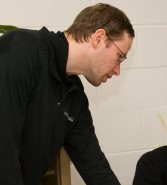
Ph.D., University of Wyoming, 1996
Phone: 718-951-5000 x2830
Grant Support: NIH SCORE: $480,000
Nature of Research
Our group is interested in fundamental aspects of organic and synthetic chemistry. One of the following topics would be the subject of inquiry during the laboratory rotation.
1. Marine invertebrate chemical helps us fight cancer
Promising future for synthetic polysulfur compounds
New strategy could help beat fungal infection
Cancer challenge underestimated?
How we can judge the bioactivity of molecules
Project: Synthesis of a New Type of Water-Soluble Polysulfane Antitumor Agent. Benzopentasulfane possesses impressive antitumor activity, but has poor water solubility. Because of the limited water-solubility of benzopentasulfane, difficulties exist for its use in biological applications. We recognized literature examples, in which the substitution of glucuronic acid into a variety of compounds greatly enhanced their water-solubility. Inspired by this, our plan is to synthesize a water-soluble glucuronide-benzopentasulfane compound to overcome low solubility in water and human plasma. This research aims to: (1) synthesize a glucuronide derivative of benzopentasulfane, where the glucuronic acid is connected by a 3-nitrobenzyl ether linker to the OH group of 7-hydroxybenzopentasulfane, and (2) establish HPLC and LCMS methods to detect the glucuronide-benzopentasulfane compound in aqueous media. Purifications of the synthetic samples will be conducted by TLC and HPLC, and structure elucidation will be confirmed by HRMS, LCMS, single-ion-mode (SIM) GCMS, 1H and 13C NMR. We emphasize that synthetic alterations to natural polysulfanes can offer leads for drug discovery. For example, the new glucuronic acid polysulfane may rendezvous with the enzyme gluconidase, which is present in the extracellular region of some tumor cells.
References:
D. Aebisher; E. M. Brzostowska; M. Adaickapillai; A. Greer “Regioselective (Biomimetic) Synthesis of a Pentasulfane From Ortho-benzoquinone” J. Org. Chem. 2007, 72, 2951-2955. E. M. Brzostowska; M. Paulynice; R. Bentley, A. Greer “Planar Chirality Due to a Polysulfur Ring in Natural Pentathiepin Cytotoxins. Implications of Planar Chirality for Enantiospecific Biosynthesis and Toxicity” Chem. Res. Toxicol. 2007, 20, 1046-1052.
2. Fiber optics in action in organic chemistry
Toxic chemical delivered by fiber
Water Disinfection
Secret power of reactive oxygen species
Project: Singlet Oxygen Delivery in vivo Via a Fiber Optic-bound Photosensitizer. This project focuses on the generation of singlet oxygen as a therapeutic agent and disinfecting agent. Photodynamic therapy (PDT) hinges on the use of intravenously injected photosensitizers to generate singlet oxygen for the treatment of tumors in, for example, skin and esophageal cancers. Our novel heterogeneous PDT method aims to provide a means to substantially improve on the current limitations in PDT. The optical excitation of sensitizer molecules attached to porous glass ends on hollow photonic band-gap optical fiber through which oxygen flows offers an improved means to generate singlet oxygen in vivo. Water Disinfection: Our research is also directed at improving water quality. The singlet oxygen fiber may provide a useful application of benefit to society. The World Health Organization (WHO) International is promoting this topic since 1 billion people in the world have access to contaminated water. Much research could be done to improve the quality of people’s lives. We will use organic and analytical chemistry methods with fiber optic technology to lead to singlet oxygen mediated processes to rid E. coli from wastewater. Students will gain experience with synthetic methods of glass materials and fabrications of porous membranes, in addition to using photochemical methods a Xenon arc lamp and a pulsed-laser with a variety of wavelengths for excitation.
References:
A. Greer “Organic Chemistry: Molecular Crosstalk” Nature 2007, 447, 273-274; A. Greer “Perspective: A View of Unusual Peroxides” Science 2003, 302, 235-236.
3. No reagent left behind
Developing new chemical synthetic processes
Back to basics
Fundamentals of organic and synthetic chemistry
Chemical evolution’s uncertain future
Making new molecules and materials remain the keys to organic chemistry. Most everything depends on them.
Rotation Projects
Research activities involve the use of experimental and computational techniques. Students will gain experience in a variety of organic chemistry techniques by utilizing equipment available at Brooklyn College: (i) Preparative: (1) Shimadzu-17A auto-sampler capillary gas chromatograph equipped with a flame ionization detector; (2) Perkin Elmer HPLC equipped with an LC 250 pump, a C18 column and a diode array detector, (ii) Photochemical: (1) a 350W arc lamp; (2) pulsed Nd:YAG laser with harmonic generators for 1064 nm, 532 nm, 355 nm, and 266 nm excitation, (iii) Characterization: (1) Brucker 400 1H NMR spectrometer; (2) Agilent Technologies GC/MS instrument; and(3) Agilent Technologies LC/MS instrument, and (iv) Calculations: thermodynamic properties such as activation enthalpies using Møller-Plesset (MP2), Gaussian-3 (G3), and Becke3LYP (B3LYP) methods. Basis sets such as 6-31G(d), 6-31+G(d), and D95** will be used.